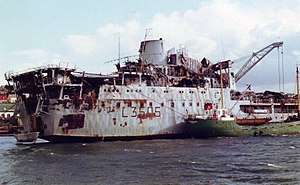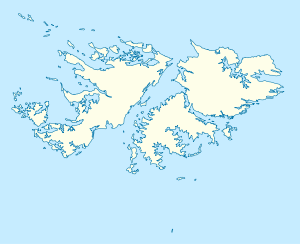Bluff Cove air attacks
The Bluff Cove air attacks occurred 8 June 1982, during the Falklands War. British troop transport ships were bombed by the Argentine Air Force (FAA) whilst unloading, with significant damage and casualties.
Background
By 1 June, British forces on the Falkland Islands were bolstered by the arrival of 5,000 new troops of the 5th Infantry Brigade. Major General Jeremy Moore now had sufficient force to start planning a full-scale assault on Port Stanley.
Advance parties of the 2nd Battalion, Parachute Regiment moved forward and occupied Fitzroy and Bluff Cove, when it was discovered to be clear of Argentine forces. Units of the Welsh Guards and Scots Guards were to be sent in to support them. After the sinking of the transport Atlantic Conveyor there was only one British heavy-lift helicopter available, an RAF CH-47 Chinook, Bravo November.[3] Therefore, supplies and reinforcements would have to be transported by ships of the Royal Fleet Auxiliary,[4] which were manned by civilian sailors.[5]
Air strikes
While unloading on 8 June, the British ships were attacked by two waves of A-4 Skyhawks from the Argentine Air Force's 5th Air Brigade, each of them loaded with three 500 lb retarding tail bombs of Spanish design.[6] The airstrikes had been called in by Argentine commandos of 602 Commando Company after they spotted the ships from their position on Mount Harriet.[7] The fighters departed from Río Gallegos airbase, which at the time was monitored by the British nuclear submarine HMS Splendid.[8] The first package, originally made of eight aircraft, was reduced to five when three Skyhawks returned to base due to refuelling problems.[9] On their way to Bluff Cove, the package overflew a Scout helicopter from 656 Squadron; the Scout, XR628, was forced to make a hard landing on McPhee Pond. The aircraft was eventually written off.[10][11]
Six Argentine IAI Dagger fighters simultaneously took off from airbase at Río Grande for a complementary mission, led by a Learjet which provided navigation information. One of the Daggers subsequently returned to base due to refueling issues. The attacking aircraft were preceded by four Mirage III fighters which took off from Río Grande airbase to carry out a decoy mission over the north of the islands in order to draw away the British Sea Harriers and allow the Skyhawks and Daggers to carry out their attacks unmolested, while the Argentine destroyer ARA Santísima Trinidad broadcast interference signals to jam the frequencies used by the Royal Navy's air controllers directing Sea Harrier operations.[12][13] The nuclear submarine HMS Valiant, on picket duty off Río Grande, was able to track the six Dagger fighters that took off from the airbase there, but the report from the submarine failed to reach the British forces at Bluff Cove.[14]
First strike
At approximately 14:00 local time the ships RFA Sir Tristram and RFA Sir Galahad were badly damaged[15] by five A-4Bs of Grupo 5. Three A-4s targeted Sir Galahad, which was hit by three bombs released from the Skyhawk flown by First Lieutenant Carlos Cachón. The second Skyhawk was unable to drop its bombs, and the third overshot the British ship.[14]
The remaining two aircraft attacked Sir Tristram, which was struck by two bombs released by package leader Lieutenant Daniel Gálvez; the bombs of the last A-4 fell short.[14] The explosions and subsequent fires killed 48 men aboard Sir Galahad, of whom 32 were soldiers from the Welsh Guards, 11 were other army personnel, and five were crewmen of the Sir Galahad, among them two Hong Kong Chinese sailors. The attack on Sir Tristram killed two crewmen, both of them Hong Kong Chinese sailors.[16][17]
Second strike
At 16:50 a second wave, composed by four A-4Bs of Grupo 5 hit and sank the Landing Craft Utility (LCU) Foxtrot-4 from HMS Fearless in Choiseul Sound.[18] The landing barge was ferrying the vehicles and communications equipment of the 5th Brigade's headquarters from Darwin to Bluff Cove. Six Royal Marines on board were killed. However, this time the Sea Harrier combat air patrol was already on scene and responded; three Skyhawks were shot down and their pilots, First Lieutenant Danilo Bolzan, Lieutenant Juan Arrarás, and Ensign Alfredo Vazquez were killed.[19]
Bolzan and Vazquez were shot down by Flight Lieutenant David Morgan while Arrarás was shot down by Morgan's wingman, Lieutenant David Smith.[20][21][22] The fourth aircraft, which was flown by First Lieutenant Héctor Sánchez, suffered combat damage and lost a large amount of fuel, but returned to the mainland assisted by a KC-130 tanker. A third wave, by A-4Cs of Grupo 4, arrived minutes later and struck ground targets without visible success.[19]
Attack on HMS Plymouth
In a separate incident, the frigate HMS Plymouth endured the sudden attack of the Daggers from Rio Grande, which struck her with four 1,000-pound bombs. The warship sustained severe damage, and five crewmen were injured. Although all the bombs were duds, the attack caused the explosion of at least one depth charge on her flight deck.[23]
Aftermath
A total of 56 British servicemen were killed, and 150 wounded.[2] The incident marked the single greatest loss of life among British forces in a single incident since World War II and accounted for one-fifth of British fatalities in the entire Falklands War.[24] Sir Galahad was damaged beyond repair and scuttled, but her sister ship survived to be re-built post-war. American author Robert Bolia blames the disaster on the use of large LST ships instead of LCUs and other small vessels.[4]
BBC television cameras recorded images of Royal Navy helicopters hovering in thick smoke to winch survivors from the burning landing ships.[25] These images were seen around the world. However, General Mario Menendez, commander of Argentine forces on the islands, was told that hundreds of men had been killed. He expected a drop in British morale, and their advance to slacken.[26] In fact, the attacks delayed the scheduled British advance on Port Stanley by just two days, and Argentine forces on the Falkland Islands surrendered six days after the incident.[27]
According to Brigadier Julian Thompson;
[5 Brigade] actually hadn't seen the Argentine Air Force work, 'cause for the five days they'd been there, the bad weather had kept the Argentine Air Force away; so they hadn't seen how deadly those guys could be. I can tell you, if I'd have been on board that ship I would have swam ashore rather than stay there[28]
Among the wounded was Simon Weston,[29] who later featured in a BBC documentary showing his treatment for the appalling injuries he received. Weston endured 75 operations in 22 years, after 25% of his skin suffered third degree burns. In a subsequent documentary, filmed in Argentina, he met the pilot who bombed his ship, Carlos Cachón, then retired with the rank of Captain. After a later visit of Cachón and his family to Weston's home in Liverpool, they have become great friends.[30]
Carlos Cachón was born near Balcarce and raised in Mar del Plata, where he currently lives. He is the chief of the security staff in the local offices of the Argentina National Bank. Cachón was awarded the honorific title of "Illustrious Citizen" by the City Council of Mar del Plata on 25 February 2010.[31]
After the war, a memorial for the British soldiers killed in the attack was erected at Fitzroy,[32][33] along with a separate memorial to the ships' crew who lost their lives.
References
- Bolia, Robert S. "The Falklands War:The Bluff Cove Disaster" (PDF). Military Review (November–December 2004): 71. Archived from the original (PDF) on 16 March 2012.
- Hickman, Kennedy, "The Falklands War: An Overview", About.com
- McCann, Carol and Pigeau, Ross (2000). The human in command: exploring the modern military experience. Springer, p. 59. ISBN 0-306-46366-0
- Bolia, p. 68
- Puddefoot, Geoff (2010). Ready For Anything: The Royal Fleet Auxiliary 1905-1950 pp. 69-70. Seaforth Publishing. ISBN 978-1-848-32074-1.
- Moro, Rubén Oscar (1985). La guerra inaudita: historia del conflicto del Atlántico Sur. Pleamar, p. 462. ISBN 950-583-043-2. (in Spanish)
- http://www.santotodigital.com.ar/2017/03/31/foremny-vamos-a-recuperar-malvinas-aunque-lleve-decadas-o-generaciones/
- West, Nigel (2010). Historical Dictionary of Naval Intelligence. Scarecrow Press, p. 36. ISBN 0-8108-6760-5
- West, p. 38
- "656 Sqn - British Army & Royal Marine Aviation". sites.google.com. Retrieved 8 June 2018.
- Burden, Rodney A. (1986). Falklands: The Air War. British Aviation Research Group. p. 406. ISBN 0906339057.
- West, p. 37
- https://smallwarsjournal.com/documents/bolia1.pdf
- West, p. 39
- "Task Force Falklands: Goose Green", National Army Museum, archived from the original on 19 July 2009, retrieved 20 January 2010
- Casualty Lists of the Royal Navy, 1980–89
- "The war within". South China Morning Post. Invalid date. Retrieved 2020-07-16. Check date values in:
|date=(help) - Schofield, Frank (1999). The Falklands watcher. Brewin, 114. ISBN 1-85858-140-0
- Moro, Rubén Oscar (2003). La guerra inaudita: historia del conflicto del Atlántico Sur. Buenos Aires: Edivem. ISBN 987-96007-3-8. (in Spanish)
- Chant, Christopher (2001). Air War in the Falklands 1982. Osprey Publishing, pp. 90-91. ISBN 1-84176-293-8
- Musciano, Walter A. (1994). Warbirds of the Sea: A History of Aircraft Carriers & Carrier-based Aircraft. Schiffer Publishing. ISBN 978-0-88740-583-9.
- Posey, Carl A. "Air War in the Falklands". Air & Space Magazine. Retrieved 23 July 2020.
- Chun, Clayton K S. (2001). Aerospace power in the twenty-first century: a basic primer. Diane publishing, p. 235. ISBN 1-58566-091-4
- "Fitzroy and the Welsh Guards". History Learning Site. Retrieved 16 July 2020.
- "Falklands War Compilation, (Clip 6)", ITN Source, 1982
- Anderson, Duncan (2002). The Falklands War 1982. Volume 15 of Essential histories. Osprey Publishing, p. 61. ISBN 1-84176-422-1
- https://home.bt.com/news/on-this-day/june-8-1982-56-die-at-bluff-cove-as-argentine-jets-bomb-sir-galahad-and-sir-tristram-11363985293359
- Channel 5, The Great Falklands Gamble: Revealed, available at http://vimeo.com/65418997 at 34:20
- Jolly, Rick (1983). The Red and Green Life Machine. London: Century. p. 124. ISBN 978-0-7126-0158-0.
- "I'm honoured. I'm just a little fat bloke", by Rachel Tinniswood, Liverpool Echo, 7 September 2001
- "El Concejo distinguirá a Carlos Cachón – mdphoy.com" (in Spanish). Retrieved 3 June 2020.
- Belcher, John (2000), "After the Battle", britains-smallwars.com, archived from the original on 5 January 2010, retrieved 20 January 2010
- Meersschaert, Hendrik, The South Atlantic Medal to Mark Gibby, archived from the original on 22 June 2009, retrieved 20 January 2010

